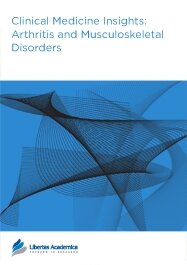

Publication Date: 14 May 2008
Journal: Clinical Medicine Insights: Arthritis and Musculoskeletal Disorders

Epitope mapping allowed the location of antigenic determinants on a protein macromolecule to be identified. In particular, pepscan techniques that utilize a series of overlapping peptides, help detect key amino acid residues that are important in antibody recognition and binding. In a previous study, we employed 15-mer peptides spanning the entire length of IgG1Fc to ascertain successfully the target epitopes of isotypic/allotypic monoclonal reagents. As an extension to this work we have used these peptides to evaluate the location of epitope targets of five IgM rheumatoid factor antibodies (RFAbs). Overall, 2 antibodies, RFAb TS2 and TS1, detected a similar epitope within the CH3 domain (360-KNQVSLTCLVKGFYP-374), whilst 1 (RFAb SJ1) recognised an epitope in the CH2 domain (294- EQYNSTYRVVSVLTV-308). In contrast, 2 RFAbs, PRSJ2 and PRTS1 detected four and five epitopes respectively within the Fc region. RFAb PRSJ2 recognised epitopes detected by RFAB TS2 and TS1 but also further epitopes in the CH2 domain (256-TPEVTCVVVDVSHED-270) and CH3 domain (418-QQGNVFSCSVMHEAL-432). Similarly, RFAb PRTS1 detected all four epitopes plus a fifth in the CH3 domain (382-ESNGQPENNYKTTPP-396). In essence there was a consensus of target epitopes identified by these rheumatoid factor antibodies. Interestingly, two epitopes (256–270, CH2 domain and 360–374, CH3 domain) were novel in that they had not been identified in previous pepscan studies. The other epitopes recognised, either overlapped or were immediately adjacent to previous epitopes detected by poly/monoclonal rheumatoid factor antibodies. Molecular modelling (PCImdad) of IgG1Fc showed that all five epitopes were exposed and surface accessible for antibody interaction. In addition, a bioinformatics analysis of the Fc region using ExPASy was employed to identify key antigenic determinants. This ‘in silico’ approach may provide a means of determining key regions without the need to develop overlapping peptides spanning the entire length of a macromolecule.
PDF (572.52 KB PDF FORMAT)
RIS citation (ENDNOTE, REFERENCE MANAGER, PROCITE, REFWORKS)
BibTex citation (BIBDESK, LATEX)
The staff of Libertas Academica have been exceptionally easy to work with. They continually keep authors updated and are responsive to all requests. They were also very flexible to work with when I had some challenges from my end as an author. Article reviews were received very promptly and were constructive and helpful for improving the manuscript. The online submission system was easy to use and provided clear guidance on what was needed. I highly ...

All authors are surveyed after their articles are published. Authors are asked to rate their experience in a variety of areas, and their responses help us to monitor our performance. Presented here are their responses in some key areas. No 'poor' or 'very poor' responses were received; these are represented in the 'other' category.See Our Results
Copyright © 2013 Libertas Academica Ltd (except open access articles and accompanying metadata and supplementary files.)
FacebookGoogle+Twitter
PinterestTumblrYouTube